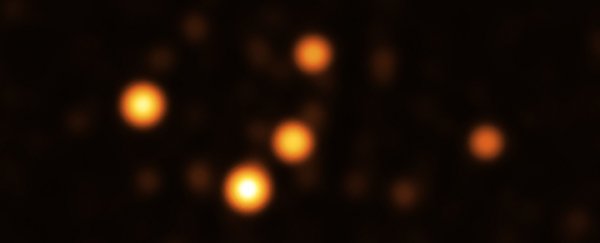In the heart of the Milky Way, stars tread a complex measure.
Bound by the gravitational field of the supermassive black hole in the galactic center, Sagittarius A*, a group of stars known as S-stars swoop on wild, years-long orbits. These orbits were recently studied to measure Sgr A*, a result that won the scientists involved a Nobel prize in physics.
But that doesn't mean the work was done, and now a team of researchers led by one of those scientists, Reinhard Genzel of the Max Planck Institute for Extraterrestrial Physics in Germany, has unveiled the fruits of their latest gaze into the abyss.
So deep are these newly captured images, that the team has identified an entirely new S-star, named S300, and refined estimates of the distribution of mass in the galactic center.
"We want to learn more about the black hole at the centre of the Milky Way, Sagittarius A*," Genzel explains.
"How massive is it exactly? Does it rotate? Do stars around it behave exactly as we expect from Einstein's general theory of relativity? The best way to answer these questions is to follow stars on orbits close to the supermassive black hole. And here we demonstrate that we can do that to a higher precision than ever before."
Black holes, even supermassive behemoths like Sgr A*, are not directly visible to us, even when they're active.
The black hole itself is screened beyond the event horizon, the distance from the black hole at which even the fastest velocity in the Universe, that of light in a vacuum, is insufficient to achieve escape velocity from the immensely powerful gravitational field.
That means that no radiation that we can currently detect emerges, which means, essentially, that the black hole is invisible. But things orbiting outside the event horizon not only reveal the presence of the black hole, they can help measure its characteristics.
For this, it helps to have the most precise measurements we can reasonably obtain. This is one of the things the GRAVITY collaboration has been working on. Using the Very Large Telescope Interferometer's GRAVITY instrument, they have been peering into the galactic center to measure the motions of the S-stars around Sgr A*.
"Following stars on close orbits around Sagittarius A* allows us to precisely probe the gravitational field around the closest massive black hole to Earth, to test General Relativity, and to determine the properties of the black hole," Genzel said.
Such observations were taken between March and July 2021, observing a number of stars as they reached perinigricon – the closest point in their long, elliptical orbits around the black hole.
This included the star S29, which approached within 13 billion kilometers of Sgr*, reaching speeds over 8,740 kilometers (5,430 miles) per second (and it's not even the closest or fastest of the S-stars).
The team combined the GRAVITY observations with those of two former VLTI instruments, as well as the Keck and Gemini Observatories in the US for a longer timeframe, and then used a machine learning technique called Information Field Theory to increase the precision of the GRAVITY data.
This involved generating a model of the S-star, simulating how they would appear to GRAVITY, and then comparing their results to the real observations.
This is how they found S300, and also obtained the most precise estimate yet of Sgr A*'s mass. According to their calculations, the Milky Way's supermassive black hole clocks in at 4.3 million times the mass of the Sun, with 0.25 percent uncertainty.
That's a little up from the collaboration's previous estimate of 4.154 million times the mass of the Sun, with 0.27 percent uncertainty.
Next year, 2022, will see several S-stars reach perinigricon, which will provide further opportunity to study and refine our measurements of the galactic center.
The team's research has been published in two papers in Astronomy & Astrophysics. They can be found here and here.
